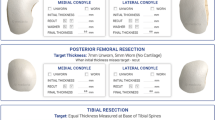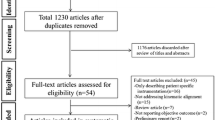Abstract
Purpose
Standard instrumentation tries to reproduce mechanical axes based on mechanical alignment (MA) guides. A kinematic alignment (KA) technique derives its plan from pre-operative MRI-measurements. This matched-pair cadaveric study compared the resulting postoperative alignments.
Methods
A prospective series of 12 torsos were acquired for a total of 24 limb specimens including intact pelvises, femoral heads, knees, and ankles.The cadavers received MRI scans to manufacture the kinematic alignment cutting guides. Two investigating surgeons performed total knee arthroplasties on randomly chosen sides using MA instruments. On the contralateral sides, KA cutting guides were used. A navigation system was used to measure final alignment.
Results
The overall alignment showed no significant differences between the systems. In the MA group the differences between the planned and the final implantation regarding overall limb alignment ranged between 0.2° and 6.2°. In the KA group the differences between the planned and final implantation regarding overall limb alignment ranged between 0.3° and 9.1°. The differences of the deviation from plan for overall limb alignment showed no significant differences between the methods.
Conclusions
The different alignment strategies resulted in variations of the combinations of the three-dimensional component position on the femur and the tibia. However, the legs were aligned within comparable range for both chosen techniques.




Similar content being viewed by others
References
Nuno-Siebrecht N, Tanzer M, Bobyn JD (2000) Potential errors in axial alignment using intramedullary instrumentation for total knee arthroplasty. J Arthroplasty 15:228–230
Stöckl B, Nogler M, Rosiek R, Fischer M, Krismer M, Kessler O (2004) Navigation improves accuracy of rotational alignment in total knee arthroplasty. Clin Orthop Relat Res 426:180–186
Harvie P, Sloan K, Beaver RJ (2011) Three-dimensional component alignment and functional outcome in computer-navigated total knee arthroplasty a prospective, randomized study comparing two navigation systems. J Arthroplasty 26:1285–1290. doi:10.1016/j.arth.2010.12.022
Molli RG, Anderson KC, Buehler KC, Markel DC (2011) Computer-assisted navigation software advancements improve the accuracy of total knee arthroplasty. J Arthroplasty 26:432–438. doi:10.1016/j.arth.2010.01.002
Schmitt J, Hauk C, Kienapfel H, Pfeiffer M, Efe T, Fuchs-Winkelmann S, Heyse TJ (2011) Navigation of total knee arthroplasty: rotation of components and clinical results in a prospectively randomized study. BMC Musculoskelet Disord 12:16. doi:10.1186/1471-2474-12-16
Hollister AM, Jatana S, Singh AK, Sullivan WW, Lupichuk AG (1993) The axes of rotation of the knee. Clin Orthop Relat Res 290:259–268
Coughlin KM, Incavo SJ, Churchill DL, Beynnon BD (2003) Tibial axis and patellar position relative to the femoral epicondylar axis during squatting. J Arthroplasty 18:1048–1055
Eckhoff DG, Bach JM, Spitzer VM, Reinig KD, Bagur MM, Baldini TH, Rubinstein D, Humphries S (2003) Three-dimensional morphology and kinematics of the distal part of the femur viewed in virtual reality. Part II. J Bone Joint Surg (Am) 85-A(Suppl 4):97–104
Incavo SJ, Coughlin KM, Pappas C, Beynnon BD (2003) Anatomic rotational relationships of the proximal tibia, distal femur, and patella: implications for rotational alignment in total knee arthroplasty. J Arthroplasty 18:643–648
Eckhoff DG, Bach JM, Spitzer VM, Reinig KD, Bagur MM, Baldini TH, Flannery NM (2005) Three-dimensional mechanics, kinematics, and morphology of the knee viewed in virtual reality. J Bone Joint Surg (Am) 87(Suppl 2):71–80. doi:10.2106/JBJS.E.00440
Stryker Corporation. Triathlon® Knee System Surgical Protocol (2011) Stryker Orthopaedics, Mahwah, NJ
Stryker Corporation. Triathlon® Knee System with OtisMed® ShapeMatch® Technology. Surgical Protocol (2011) Stryker Orthopaedics, Mahwah, NJ
Acknowledgements
We would like to thank Mag. Dennis Huber for his help with the study design and statistics.
Conflict of interest
This study was funded by Stryker Corp. While Stryker provide the materials and funding, the company did not plan the experiment, interpret the data or write the manuscript.
William Hozack, Dermot Collopy, Eckart Mayr, and Michael Nogler are paid consultants for Stryker Corp.
Eckart Mayr and Michael Nogler are presentation speakers for Stryker Corp.
Michael Nogler receives research support from Stryker Corp.
William Hozack receives royalties from Stryker Corp.
No further conflicts of interest to declare.
Author information
Authors and Affiliations
Corresponding author
Rights and permissions
About this article
Cite this article
Nogler, M., Hozack, W., Collopy, D. et al. Alignment for total knee replacement: a comparison of kinematic axis versus mechanical axis techniques. A cadaver study. International Orthopaedics (SICOT) 36, 2249–2253 (2012). https://doi.org/10.1007/s00264-012-1642-2
Received:
Accepted:
Published:
Issue Date:
DOI: https://doi.org/10.1007/s00264-012-1642-2




